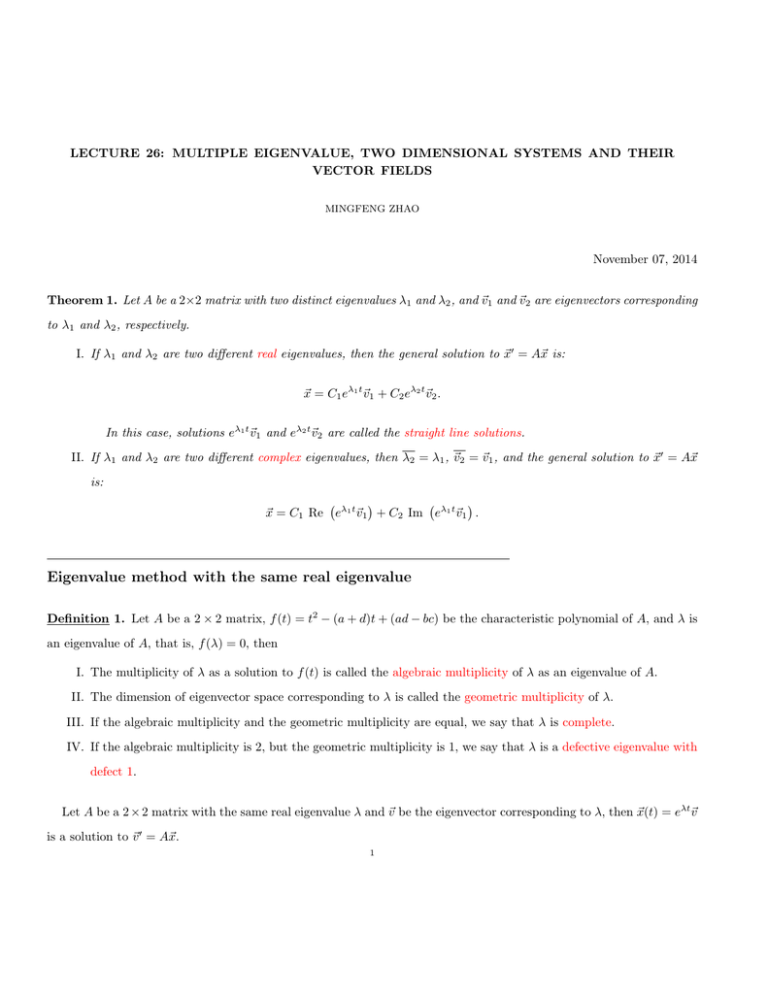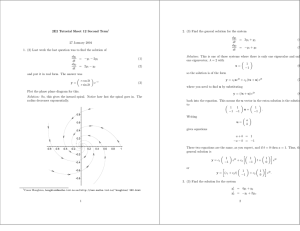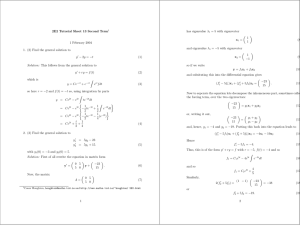LECTURE 26: MULTIPLE EIGENVALUE, TWO DIMENSIONAL SYSTEMS AND THEIR VECTOR FIELDS
advertisement

LECTURE 26: MULTIPLE EIGENVALUE, TWO DIMENSIONAL SYSTEMS AND THEIR VECTOR FIELDS MINGFENG ZHAO November 07, 2014 Theorem 1. Let A be a 2×2 matrix with two distinct eigenvalues λ1 and λ2 , and ~v1 and ~v2 are eigenvectors corresponding to λ1 and λ2 , respectively. I. If λ1 and λ2 are two different real eigenvalues, then the general solution to ~x0 = A~x is: ~x = C1 eλ1 t~v1 + C2 eλ2 t~v2 . In this case, solutions eλ1 t~v1 and eλ2 t~v2 are called the straight line solutions. II. If λ1 and λ2 are two different complex eigenvalues, then λ2 = λ1 , ~v2 = ~v1 , and the general solution to ~x0 = A~x is: ~x = C1 Re eλ1 t~v1 + C2 Im eλ1 t~v1 . Eigenvalue method with the same real eigenvalue Definition 1. Let A be a 2 × 2 matrix, f (t) = t2 − (a + d)t + (ad − bc) be the characteristic polynomial of A, and λ is an eigenvalue of A, that is, f (λ) = 0, then I. The multiplicity of λ as a solution to f (t) is called the algebraic multiplicity of λ as an eigenvalue of A. II. The dimension of eigenvector space corresponding to λ is called the geometric multiplicity of λ. III. If the algebraic multiplicity and the geometric multiplicity are equal, we say that λ is complete. IV. If the algebraic multiplicity is 2, but the geometric multiplicity is 1, we say that λ is a defective eigenvalue with defect 1. Let A be a 2 × 2 matrix with the same real eigenvalue λ and ~v be the eigenvector corresponding to λ, then ~x(t) = eλt~v is a solution to ~v 0 = A~x. 1 2 MINGFENG ZHAO I. If λI2 − A = 0, that is, λ is a geometric eigenvalue, then the general solution to ~x0 = A~x is 1 0 + eλt . ~x(t) = eλt 0 1 II. If λI2 − A 6= 0, that is, λ is a defective eigenvalue, then another linearly independent solution ~y to ~x0 = A~x has the form ~y (t) = eλt (t~v + w) ~ for some vector w ~ to be determined. After a simple computation, we will know that w ~ satisfies (λI2 − A)w ~ = −~v . Example 1. Solve ~x0 = 2 0 2 0 0 2 ~x. , it’s easy to say that A has only one eigenvalue λ = 2 and 2I2 − A = 0, that is, λ = 2 is a geometric 0 2 eigenvalue of A. So the general solution to ~x0 = A~x is: Let A = 2t ~x(t) = C1 e 1 2t + C2 e 0 det (λI2 − A) = det . 1 x0 = 3x1 + x2 1 Example 2. Find the general solution to . x0 = 3x 2 2 0 x = 3x1 + x2 3 1 The coefficient matrix of the system is A = x0 = 3x 0 2 2 0 λ−3 −1 0 λ−3 1 . First, let’s find eigenvalues of A, then 3 = (λ − 3)2 = 0. Then λ1 = λ2 = 3. Now let’s solve 3 1 0 3 0 −1 0 0 x1 = 3 x2 x1 . x2 Then So x1 x2 = x1 1 0 x1 x2 = 0 . 0 . Hence we know that λ = 3 is the only one eigenvalue for A, ~v = 1 is the eigenvector, 0 and 3I2 − A 6= 0, that is, λ = 3 is a defective eigenvalue of A. Then ~y (t) = e3t~v is a solution to ~x0 = A~x. LECTURE 26: MULTIPLE EIGENVALUE, TWO DIMENSIONAL SYSTEMS AND THEIR VECTOR FIELDS 3 Let ~x = e3t (t~v + w) ~ = t~y (t) + e3t w ~ be another linearly independent solution to ~x0 = A~x, then ~x0 = ~y (t) + t~y 0 (t) + 3e3t w ~ = A(t~y (t) + e3t w) ~ = tA~y (t) + e3t Aw. ~ Since ~y (t) is a solution to ~x0 = A~x, then ~y (t) + 3e3t w ~ = e3t Aw. ~ Since ~y (t) = e3t~v , then e3t~v + 3e3t w ~ = e3t Aw, ~ that is, ~v + 3w ~ = Aw. ~ Hence, (3I2 − A)w ~ = −~v , that is, 0 −1 w −1 1 = 0 0 w2 0 So we can take w1 = 0 and w2 = 1, that is, w ~ = 0 . So another solution is −1 e3t (t~v + w) ~ = e3t t 1 + 0 0 = e3t 1 t . 1 Therefore, the genera solution to ~x0 = A~x is: ~x = C1 e3t 1 + C2 e3t 0 t = 1 C1 e3t + C2 te3t C2 e3t . Two dimensional systems and their vector fields To draw the vector field of a general system ~x0 = f~(t, ~x): I. Plot the tx1 x2 -space. II. Select points as many as possible in the plane, say P1 , P2 , · · · , Pn . III. At each point Pi , draw a short arrow with direction (1, f1 (Pi ), f2 (Pi )). Remark 1. For any given initial data ~x(t0 ) = P0 , the solution ~x(t) to ~x0 = f~(t, ~x) and ~x(t0 ) = P0 is a curve in three dimensional space which parametrized by t such that this curve passes through the point P0 and has tangent vector f~(t, ~x(t)) at each point ~x(t) on the curve. In this course, we only study the two dimensional homogeneous system: x0 = f1 (x1 , x2 ) 1 x0 = f (x , x ) 2 2 1 2 4 MINGFENG ZHAO x0 = f1 (x1 , x2 ) 1 The vector field of is the projection on the x1 x2 -plane of its three dimensional vector field in the x0 = f (x , x ) 2 1 2 2 x0 = f1 (x1 , x2 ) 1 tx1 x2 -space. To draw the vector field of : x0 = f (x , x ) 2 1 2 2 I. Plot the x1 x2 -plane. II. Select points as many as possible in the plane, say P1 , P2 , · · · , Pn . III. At each point Pi , draw a short arrow with direction (f1 (Pi ), f2 (Pi )). Remark 2. For any given initial data ~x(t0 ) = P0 , the solution ~x(t) to ~x0 = f~(~x) and ~x(t0 ) = P0 is a curve which parametrized by t such that this curve passes through the point P0 and has tangent vector f~(~x(t)) at each point ~x(t) on the curve. x0 = xy Example 3. Draw the vector field of the system y0 = x + y Department of Mathematics, The University of British Columbia, Room 121, 1984 Mathematics Road, Vancouver, B.C. Canada V6T 1Z2 E-mail address: mingfeng@math.ubc.ca




